Luba lukova
Download as ppt, pdf1 like1,572 views
art, social change, graphic design, luba lukova
1 of 25
Downloaded 18 times
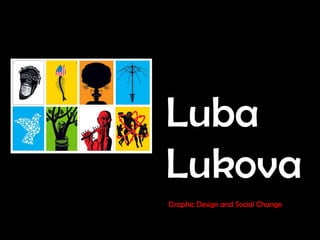

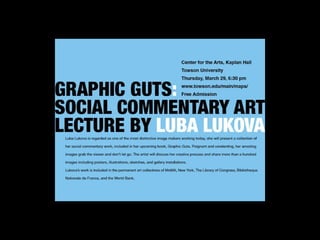

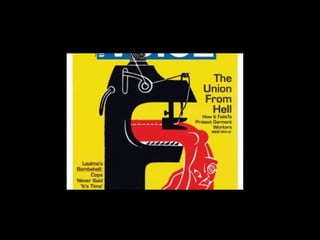

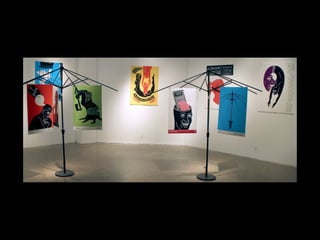
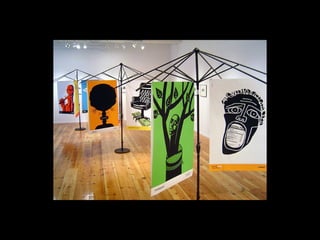
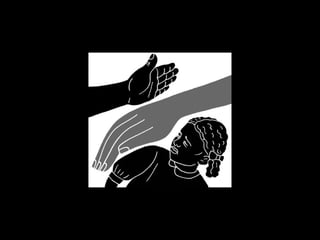


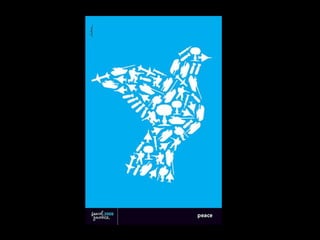
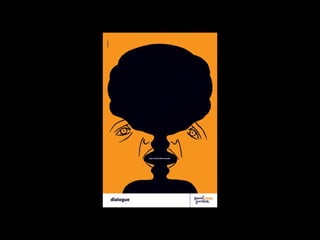
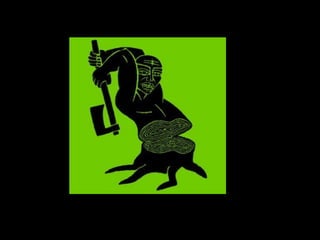
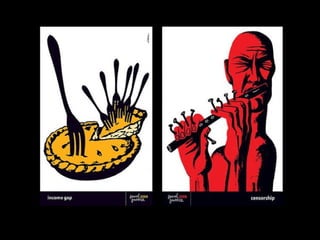
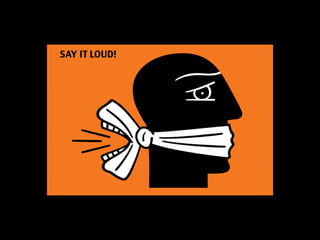

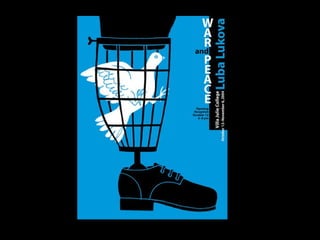
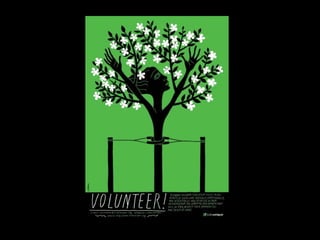
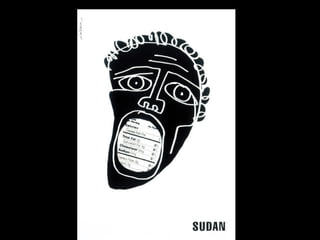
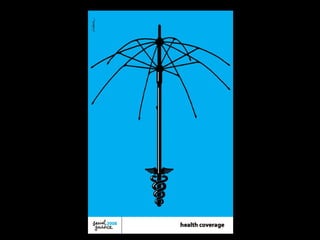


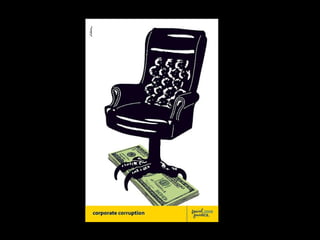

Ad
Recommended
Junk food art
Junk food artLaura Johnson
?
This document contains information about three artists - Pamela Michelle Johnson, Lee Price, and Wayne Thiebaud - who incorporate themes of food and consumption in their work. Pamela Johnson creates paintings of junk food to invoke reflection on American culture's focus on mass consumption. Lee Price paints herself gorging on junk food to explore women's complicated relationship with food and eating disorders. Wayne Thiebaud is known for his colorful paintings of everyday food items like pies and cakes, pushing painting techniques while playing on nostalgia.Zentangle Portraits
Zentangle PortraitsLaura Johnson
?
This document provides instructions for creating a Zentangle self portrait using pen shading techniques like stippling, scribbling, hatching and cross hatching. It recommends zooming in or cropping the subject and placing it off center for composition, then isolating one square at a time to apply the different shading techniques to create the portrait. An option is to weave the reference photo first before drawing.Linocut Examples.ppt
Linocut Examples.pptLaura Johnson
?
This document provides information on various artists and their linocut works. It lists the names of over 15 artists such as Mark Hearld, Angie Lewin, Nick Morley, Kreg Yingst, and Darrel Perkins who have created linocut illustrations, portraits, and series. It also describes linocut exhibitions in London and provides details on the linocut process from several artists like Aijung Kim, James Green, and students at Seymour Road Studios.Linocut Portraits
Linocut PortraitsLaura Johnson
?
Linocut is a printmaking technique where a design is carved into a linoleum block, ink is applied to the carved areas, and paper is pressed onto the block to transfer the image. The document shows the tools used in linocut printing including a brayer to apply ink, a lino block with carved design, a baren to apply pressure, and lino cutters of various sizes used to carve into the block. Examples of linocut prints are also shown, including a 1968 portrait and 1912 and 1913 woodcut prints from German Expressionist artists.Escaping The Cave
Escaping The CaveLaura Johnson
?
The document discusses reinvigorating art education through collaboration, technology, and creative solutions in response to challenges such as stagnation and budget restraints. It emphasizes the importance of personal learning communities (PLCs), free resources, and civic engagement, providing various platforms and initiatives for educators and students to connect and innovate. Additionally, it lists grant opportunities and collaborative art initiatives aimed at enhancing creativity and community involvement in art education.Contour Line and Creating Emphasis with Color
Contour Line and Creating Emphasis with ColorLaura Johnson
?
The document discusses the use of contour lines and color to create emphasis in art, referencing various artists and student examples. It includes mentions of works by notable figures such as David Hockney and Mary Cassatt. The content highlights different artistic collaborations and expressions associated with emphasizing color in artwork.Alternative Typography
Alternative TypographyLaura Johnson
?
Alternative typography explores experimental uses of type that break from traditional conventions. This includes manipulating type in unconventional ways through techniques like distortions, overlays, and unconventional placements on a page. The goal is to find new expressive possibilities for communication and expression through non-standard typographic designs.MultipleViews and Perspectives
MultipleViews and PerspectivesLaura Johnson
?
This document lists the names of 18 individuals who provided multiple views and perspectives on an unspecified topic. It does not provide any further context or details about the views and perspectives of these 18 individuals.Popular logos with hidden symbolism
Popular logos with hidden symbolismLaura Johnson
?
This document discusses several popular logos that contain hidden symbolisms or meanings not immediately apparent. It provides examples of logos for companies or organizations like the Big Ten conference, Goodwill, Amazon, Toblerone, Baskin Robins, FedEx, Continental Airlines, the Milwaukee Brewers, and Northwest Airlines that encode additional symbolic information through negative space, embedded images, or other subtle design elements related to their business, history or values.Sculpture with multiples
Sculpture with multiplesLaura Johnson
?
The document discusses the works of several prominent artists, including American Tara Donovan, Ghanaian El Anatsui, and British Andy Goldsworthy. It emphasizes their unique approaches to sculpture, focusing on repetition and variation in their art. Each artist's distinct style and contributions are briefly highlighted.Color in Paintings
Color in PaintingsLaura Johnson
?
This document provides information on various abstract, modernist, and expressionist artworks from the early 20th century including paintings by Kandinsky, Mondrian, Monet, Rothko, Klee, Dove, Davis, Munter, MacDonald-Wright, Kirchner and Miro. It includes titles, artists, dates and locations of works, as well as brief quotes from some of the artists about their artistic approaches and philosophies.Shutter Speed and Aperture
Shutter Speed and ApertureLaura Johnson
?
Shutter speed and aperture are tools that photographers use to control the amount of light entering the camera. Shutter speed refers to how long the shutter remains open and is measured in fractions of seconds, with faster speeds freezing motion and slower speeds allowing blur. Aperture, measured in f-stops, controls depth of field and how much of the scene is in focus, with higher f-stops having less light and greater depth of field. Photographers can use different shutter speeds and apertures to capture scenes with stopped, blurred, or panned motion.Pointillism Painting Project
Pointillism Painting ProjectLaura Johnson
?
Georges-Pierre Seurat was a French Neo-Impressionist painter in the late 19th century who developed the technique of pointillism. Pointillism involved applying small dots or points of pure color close together so that from a distance they visually blend in the eye of the observer. Seurat was inspired by scientific theories on color and contrast, and used this technique to carefully organize color on his canvases. He would labor for up to a year on preparatory studies before beginning a final painting using the pointillist method.Altered Book Workshop
Altered Book WorkshopLaura Johnson
?
An altered book is a book that has been creatively modified or decorated in some way. According to the International Society of Altered Book Artists, an altered book can be any book that has been recycled into a work of art through techniques like painting, collaging, stamping or sculpting. Altered books can range from simply adding drawings or text to completely transforming the book into an intricate sculpture.Symbolic Self Portrait Powerpoint
Symbolic Self Portrait PowerpointLaura Johnson
?
This document provides instructions for creating a symbolic still life self portrait using a collection of meaningful objects that represent the person. The instructions specify to gather favorite possessions of different sizes, textures, and levels of light and darkness that relate to one's interests and hobbies in order to assemble an arrangement of items symbolizing oneself.Surrealism ppt
Surrealism pptLaura Johnson
?
Originally a literary movement, Surrealism explored dreams, the unconscious mind, and the intersection of reality and imagination. Inspired by World War I destruction and Sigmund Freud's theories of the mind, early Surrealist artists like Salvador Dali, Rene Magritte, and Joan Miro created works featuring illogical juxtapositions and impossible realities to represent inner psychic processes. Their surreal paintings, filled with dreamlike and disturbing images, became popular in France and other European countries in the 1920s.Fauvism
FauvismLaura Johnson
?
Fauvism was an early 20th century avant-garde art movement known for its use of bright, arbitrary colors and expressive brushwork. Key figures included Henri Matisse and Andre Derain. Their works were first exhibited together in 1905 and were criticized for their wild, unnatural colors, leading to the name "Fauves" meaning wild beasts. Matisse's painting Woman with a Hat was particularly attacked but also purchased by Gertrude and Leo Stein, boosting Matisse's confidence. Both Matisse and Derain were inspired by color and reimagining the visual world through color.Maori Ta Moko Project
Maori Ta Moko ProjectLaura Johnson
?
Ta Moko is a traditional Māori tattooing art form that holds deep cultural significance. The tattoos tell stories of a person's identity and ancestry through intricate patterns and designs that follow the natural contours of the face and body. Ta Moko was historically applied using chisels and pigments but is now done with tattoo machines. Modern views on non-Māori receiving Ta Moko tattoos are varied, from being seen as inappropriate cultural appropriation to a form of cultural sharing if done sensitively.Morocco
Morocco Laura Johnson
?
Morocco is slightly larger than California with a population of 35 million people. The majority of Moroccans are Arab-Berber and Muslim. While Arabic is the official language, French and Berber dialects are also commonly used. Literacy rates are around 52% overall but are much lower for women, especially in rural areas. Education is free through primary school but many children, especially girls, do not attend due to low literacy in rural areas. The capital city is Rabat.Joseph Cornell
Joseph CornellLaura Johnson
?
Joseph Cornell was an American artist known for his box constructions and collages made from found objects. He lived reclusively in Queens, New York with his mother and brother, venturing out to scavenge relics from the past in junk shops and flea markets. Cornell saw artistic potential in objects others considered refuse. He was also focused on children and held one of the first avant-garde art exhibitions in New York designed specifically for children.Oaxacan wood carving slideshare pptLaura Johnson
?
As esculturas de madeira de Oaxaca s?o uma express?o magnífica da arte folclórica mexicana, criadas inteiramente à m?o pelos talentosos artes?os de Oaxaca a partir de madeira de copal. Suas formas ingeniosas com padr?es e cores impressionantes cativaram colecionadores em todo o mundo. Oaxaca, apesar de ser um dos estados mais pobres do México, tem uma das tradi??es artísticas folclóricas mais ricas.Watercolor postcards
Watercolor postcardsLaura Johnson
?
The document summarizes the steps and parts of a watercolor art lesson. It is divided into 3 parts: 1) Practice watercolor techniques, 2) Complete 3 small postcards, 3) Create 2 larger paintings interpreting the same subject realistically and creatively. Examples of professional watercolor paintings are also provided.Illuminated initials powerpoint
Illuminated initials powerpointLaura Johnson
?
- Monks in medieval times were the sole creators of illuminated manuscripts and copied books mainly for religious use in monasteries.
- The process involved a monk traveling to borrow a book, copying it by hand in a scriptorium, and sometimes illuminating the text with decorations.
- By the 12th century, book production expanded and became a business conducted in cities as demand increased from universities and the middle class. Scribes and illuminators were hired by booksellers to produce commissioned manuscripts.Shattered Drawing 狠狠撸show
Shattered Drawing 狠狠撸showLaura Johnson
?
Cubism was an early 20th century avant-garde art movement that revolutionized European painting and sculpture. Led by Pablo Picasso and Georges Braque, Cubism involved analyzing subjects by breaking them into geometric forms and depicting them from multiple perspectives and points of view in the same canvas. Cubism broke from traditional perspective in painting and used color reduction, focusing on browns and grays to emphasize form over color.More Related Content
More from Laura Johnson (20)
Alternative Typography
Alternative TypographyLaura Johnson
?
Alternative typography explores experimental uses of type that break from traditional conventions. This includes manipulating type in unconventional ways through techniques like distortions, overlays, and unconventional placements on a page. The goal is to find new expressive possibilities for communication and expression through non-standard typographic designs.MultipleViews and Perspectives
MultipleViews and PerspectivesLaura Johnson
?
This document lists the names of 18 individuals who provided multiple views and perspectives on an unspecified topic. It does not provide any further context or details about the views and perspectives of these 18 individuals.Popular logos with hidden symbolism
Popular logos with hidden symbolismLaura Johnson
?
This document discusses several popular logos that contain hidden symbolisms or meanings not immediately apparent. It provides examples of logos for companies or organizations like the Big Ten conference, Goodwill, Amazon, Toblerone, Baskin Robins, FedEx, Continental Airlines, the Milwaukee Brewers, and Northwest Airlines that encode additional symbolic information through negative space, embedded images, or other subtle design elements related to their business, history or values.Sculpture with multiples
Sculpture with multiplesLaura Johnson
?
The document discusses the works of several prominent artists, including American Tara Donovan, Ghanaian El Anatsui, and British Andy Goldsworthy. It emphasizes their unique approaches to sculpture, focusing on repetition and variation in their art. Each artist's distinct style and contributions are briefly highlighted.Color in Paintings
Color in PaintingsLaura Johnson
?
This document provides information on various abstract, modernist, and expressionist artworks from the early 20th century including paintings by Kandinsky, Mondrian, Monet, Rothko, Klee, Dove, Davis, Munter, MacDonald-Wright, Kirchner and Miro. It includes titles, artists, dates and locations of works, as well as brief quotes from some of the artists about their artistic approaches and philosophies.Shutter Speed and Aperture
Shutter Speed and ApertureLaura Johnson
?
Shutter speed and aperture are tools that photographers use to control the amount of light entering the camera. Shutter speed refers to how long the shutter remains open and is measured in fractions of seconds, with faster speeds freezing motion and slower speeds allowing blur. Aperture, measured in f-stops, controls depth of field and how much of the scene is in focus, with higher f-stops having less light and greater depth of field. Photographers can use different shutter speeds and apertures to capture scenes with stopped, blurred, or panned motion.Pointillism Painting Project
Pointillism Painting ProjectLaura Johnson
?
Georges-Pierre Seurat was a French Neo-Impressionist painter in the late 19th century who developed the technique of pointillism. Pointillism involved applying small dots or points of pure color close together so that from a distance they visually blend in the eye of the observer. Seurat was inspired by scientific theories on color and contrast, and used this technique to carefully organize color on his canvases. He would labor for up to a year on preparatory studies before beginning a final painting using the pointillist method.Altered Book Workshop
Altered Book WorkshopLaura Johnson
?
An altered book is a book that has been creatively modified or decorated in some way. According to the International Society of Altered Book Artists, an altered book can be any book that has been recycled into a work of art through techniques like painting, collaging, stamping or sculpting. Altered books can range from simply adding drawings or text to completely transforming the book into an intricate sculpture.Symbolic Self Portrait Powerpoint
Symbolic Self Portrait PowerpointLaura Johnson
?
This document provides instructions for creating a symbolic still life self portrait using a collection of meaningful objects that represent the person. The instructions specify to gather favorite possessions of different sizes, textures, and levels of light and darkness that relate to one's interests and hobbies in order to assemble an arrangement of items symbolizing oneself.Surrealism ppt
Surrealism pptLaura Johnson
?
Originally a literary movement, Surrealism explored dreams, the unconscious mind, and the intersection of reality and imagination. Inspired by World War I destruction and Sigmund Freud's theories of the mind, early Surrealist artists like Salvador Dali, Rene Magritte, and Joan Miro created works featuring illogical juxtapositions and impossible realities to represent inner psychic processes. Their surreal paintings, filled with dreamlike and disturbing images, became popular in France and other European countries in the 1920s.Fauvism
FauvismLaura Johnson
?
Fauvism was an early 20th century avant-garde art movement known for its use of bright, arbitrary colors and expressive brushwork. Key figures included Henri Matisse and Andre Derain. Their works were first exhibited together in 1905 and were criticized for their wild, unnatural colors, leading to the name "Fauves" meaning wild beasts. Matisse's painting Woman with a Hat was particularly attacked but also purchased by Gertrude and Leo Stein, boosting Matisse's confidence. Both Matisse and Derain were inspired by color and reimagining the visual world through color.Maori Ta Moko Project
Maori Ta Moko ProjectLaura Johnson
?
Ta Moko is a traditional Māori tattooing art form that holds deep cultural significance. The tattoos tell stories of a person's identity and ancestry through intricate patterns and designs that follow the natural contours of the face and body. Ta Moko was historically applied using chisels and pigments but is now done with tattoo machines. Modern views on non-Māori receiving Ta Moko tattoos are varied, from being seen as inappropriate cultural appropriation to a form of cultural sharing if done sensitively.Morocco
Morocco Laura Johnson
?
Morocco is slightly larger than California with a population of 35 million people. The majority of Moroccans are Arab-Berber and Muslim. While Arabic is the official language, French and Berber dialects are also commonly used. Literacy rates are around 52% overall but are much lower for women, especially in rural areas. Education is free through primary school but many children, especially girls, do not attend due to low literacy in rural areas. The capital city is Rabat.Joseph Cornell
Joseph CornellLaura Johnson
?
Joseph Cornell was an American artist known for his box constructions and collages made from found objects. He lived reclusively in Queens, New York with his mother and brother, venturing out to scavenge relics from the past in junk shops and flea markets. Cornell saw artistic potential in objects others considered refuse. He was also focused on children and held one of the first avant-garde art exhibitions in New York designed specifically for children.Oaxacan wood carving slideshare pptLaura Johnson
?
As esculturas de madeira de Oaxaca s?o uma express?o magnífica da arte folclórica mexicana, criadas inteiramente à m?o pelos talentosos artes?os de Oaxaca a partir de madeira de copal. Suas formas ingeniosas com padr?es e cores impressionantes cativaram colecionadores em todo o mundo. Oaxaca, apesar de ser um dos estados mais pobres do México, tem uma das tradi??es artísticas folclóricas mais ricas.Watercolor postcards
Watercolor postcardsLaura Johnson
?
The document summarizes the steps and parts of a watercolor art lesson. It is divided into 3 parts: 1) Practice watercolor techniques, 2) Complete 3 small postcards, 3) Create 2 larger paintings interpreting the same subject realistically and creatively. Examples of professional watercolor paintings are also provided.Illuminated initials powerpoint
Illuminated initials powerpointLaura Johnson
?
- Monks in medieval times were the sole creators of illuminated manuscripts and copied books mainly for religious use in monasteries.
- The process involved a monk traveling to borrow a book, copying it by hand in a scriptorium, and sometimes illuminating the text with decorations.
- By the 12th century, book production expanded and became a business conducted in cities as demand increased from universities and the middle class. Scribes and illuminators were hired by booksellers to produce commissioned manuscripts.Shattered Drawing 狠狠撸show
Shattered Drawing 狠狠撸showLaura Johnson
?
Cubism was an early 20th century avant-garde art movement that revolutionized European painting and sculpture. Led by Pablo Picasso and Georges Braque, Cubism involved analyzing subjects by breaking them into geometric forms and depicting them from multiple perspectives and points of view in the same canvas. Cubism broke from traditional perspective in painting and used color reduction, focusing on browns and grays to emphasize form over color.Recently uploaded (20)
Indian_Constitution_Presentation.pptx , images
Indian_Constitution_Presentation.pptx , imagesjaglandushyant
?
Indian constitution with pictures like ambedkar, institution and other relevant pics of constitution 最新版西班牙拉蒙鲁尔大学毕业证(鲍搁尝毕业证书)原版定制
最新版西班牙拉蒙鲁尔大学毕业证(鲍搁尝毕业证书)原版定制Taqyea
?
无法毕业?鉴于此购买文凭【q薇1954292140】修改拉蒙鲁尔大学成绩单电子版gpa让学历更出色,URL文凭制作流程确保学历真实性,文凭购买,毕业证办理,文凭办理只是基础业务。【q薇1954292140】一比一还原国外大学毕业证,定制国外大学学历,制作国外大学文凭,复刻国外大学毕业证书。想要真实感受拉蒙鲁尔大学最新版毕业证图片的品质点击查看详解,学位证1:1完美还原海外各大学毕业材料上的工艺:水印,阴影底纹,钢印LOGO烫金烫银,LOGO烫金烫银复合重叠。文字图案浮雕、激光镭射、紫外荧光、温感、复印防伪等防伪工艺。
主营项目:
1、真实教育部国外学历学位认证《西班牙毕业文凭证书快速办理拉蒙鲁尔大学成绩单定制》【q微1954292140】《论文没过拉蒙鲁尔大学正式成绩单》,教育部存档,教育部留服网站100%可查.
2、办理URL毕业证,改成绩单《URL毕业证明办理拉蒙鲁尔大学留信网认证》【Q/WeChat:1954292140】Buy Universitat Ramon Llull Certificates《正式成绩单论文没过》,拉蒙鲁尔大学Offer、在读证明、学生卡、信封、证明信等全套材料,从防伪到印刷,从水印到钢印烫金,高精仿度跟学校原版100%相同.
3、真实使馆认证(即留学人员回国证明),使馆存档可通过大使馆查询确认.
4、留信网认证,国家专业人才认证中心颁发入库证书,留信网存档可查.
办理URL学历与学位证书投资未来的最佳途径【q微1954292140】办理西班牙URL本科学历,办理拉蒙鲁尔大学成绩单高质量保密的个性化服务高仿真还原西班牙文凭证书和外壳,定制西班牙拉蒙鲁尔大学成绩单和信封。毕业证丢失补办URL毕业证【q微1954292140】假文凭回国找工作拉蒙鲁尔大学offer/学位证学位认证知乎、留信官方学历认证(永久存档真实可查)采用学校原版纸张、特殊工艺完全按照原版一比一制作。帮你解决拉蒙鲁尔大学学历学位认证难题。
【如何快速办理《拉蒙鲁尔大学毕业证URL成绩单》Buy Universitat Ramon Llull Transcripts】
购买日韩成绩单、英国大学成绩单、美国大学成绩单、澳洲大学成绩单、加拿大大学成绩单(q微1954292140)新加坡大学成绩单、新西兰大学成绩单、爱尔兰成绩单、西班牙成绩单、德国成绩单。成绩单的意义主要体现在证明学习能力、评估学术背景、展示综合素质、提高录取率,以及是作为留信认证申请材料的一部分。
拉蒙鲁尔大学成绩单能够体现您的的学习能力,包括拉蒙鲁尔大学课程成绩、专业能力、研究能力。(q微1954292140)具体来说,成绩报告单通常包含学生的学习技能与习惯、各科成绩以及老师评语等部分,因此,成绩单不仅是学生学术能力的证明,也是评估学生是否适合某个教育项目的重要依据!
Buy Universitat Ramon Llull Diploma《正式成绩单论文没过》有文凭却得不到认证。又该怎么办?鉴于此,购买西班牙毕业证【q微1954292140】西班牙文凭购买,西班牙文凭购买,西班牙文凭定制,西班牙文凭补办。专业在线定制西班牙大学文凭,定做西班牙本科文凭,【q微1954292140】复制西班牙Universitat Ramon Llull completion letter。在线快速补办西班牙本科毕业证、硕士文凭证书,购买西班牙学位证、拉蒙鲁尔大学Offer,URL拉蒙鲁尔大学毕业证书多少钱。Quectel M10 AT commands Arduino Microcontroller
Quectel M10 AT commands Arduino MicrocontrollerAdamSunusiHaruna1
?
Quectel M10 AT commands Arduino Microcontroller Syrian politician opposition Randa Kassis
Syrian politician opposition Randa Kassismo820325
?
Syrian politician opposition
Randa Kassis is a Franco-Syrian politician and a prominent secular figure within the Syrian opposition. Born on October 8, 1970, in Damascus, Syria, she is also an anthropologist and has worked as a commentator on cultural, political, and societal topics.
AI-Driven-Personalization-in-UX-Designing-for-One-in-a-Million.pdf
AI-Driven-Personalization-in-UX-Designing-for-One-in-a-Million.pdfSultan Shalakhti
?
Why you should attend this event
Talk Title: AI-Driven Personalization in UX: Designing for One in a Million
In this session, Sultan Shalakhti explores how artificial intelligence is reshaping user experience through smart, adaptive personalization. From e-commerce to banking, personalized design has become a key differentiator—when done right. Learn how to apply AI tools to enhance user journeys, balance personalization with privacy, and build experiences that feel uniquely human. This talk blends strategy, ethics, and real-world use cases for UX professionals ready to embrace the future.
?
????? ??????: ??????? ??????? ??????? ????????? ?? ????? ????????: ????? ???? ??? ??? ??? ???
??? ??????:
?????? ????? ????? ?? ??? ?????? ?? ???? ??? ??? ???? ?????? ????????? ????? ????? ???????? ?? ???? ??????? ????? ??????????. ?? ??????? ??????????? ??? ?????? ??????? ???? ??????? ?????? ?????? ?? ???? ???????—???? ??? ??? ?????? ?????? ??????. ?????? ??? ????? ????? ????? ?????? ????????? ?????? ??????? ???????? ?????? ??????? ??? ??????? ?????????? ????? ????? ????? ???? ????? ????????. ???? ???? ???? ??? ????????????? ???????????? ??????? ?????? ???????? ????????? ?? ???? UX.
What you will learn in this session
Understand the Core Concepts of AI-Driven Personalization
Explore UX Design Strategies for Hyper-Personalization
Identify Key Tools and Technologies Behind Personalization
Evaluate the Ethical and Privacy Considerations
Apply Personalization Tactics to Real UX ChallengesAimee White Visual Thinking, Graphic Design, Livermore
Aimee White Visual Thinking, Graphic Design, Livermoreaimeewhite13
?
Why Hire a professional Graphic Designer? Learn what makes great design and what it can do for your business.
Unified: Consistency brings trust, recognition, and recall.
If all your work can be recognized by the viewer as coming from you, they will more easily recognize you, gain a sense of trust in your business, and remember you and your message better.
Organized: Well designed content is clean and easy to take in. You want the audience to be able to quickly get your message
and have their eye drawn to elements in the order you choose by placement and scale.
White space is a good thing. It gives the eye room to rest
between elements and see your message as a whole.
Meaningful: Define your goals, your audience, and what critical information they need to know in order to act.
Genuine: Tell your story and engage your audience to
make them care about that information. The emotional
connection or human component is a powerful
compliment to analytical content.
Concept: With clear insight into your intent and your target audience’s needs and issues, design to solve the problems and bring clarity with a solution that’s valuable to the viewer.
Aimee White, Visual Thinking
for Design that Connects.(18+ CLIP!) Sophie Rain Spiderman Viral Video Clip Sophie Rain Original Video
(18+ CLIP!) Sophie Rain Spiderman Viral Video Clip Sophie Rain Original Videojamesfolkner123
?
DOWNLOAD LINK??? https://rebrand.ly/656e26/???
Full Download link: ??https://rebrand.ly/656e26/ ??
Sophie Rain Spiderman Viral Video Original Viral video took the internet by storm and amazed viewers on various social media platforms. Sophie Rain Spiderman Video, a young and talented digital creator, recently became famous thanks to this interesting video.最新版美国北密歇根大学毕业证(狈惭鲍毕业证书)原版定制
最新版美国北密歇根大学毕业证(狈惭鲍毕业证书)原版定制Taqyea
?
鉴于此,定制北密歇根大学学位证书提升履历【q薇1954292140】原版高仿北密歇根大学毕业证(NMU毕业证书)可先看成品样本【q薇1954292140】帮您解决在美国北密歇根大学未毕业难题,美国毕业证购买,美国文凭购买,【q微1954292140】美国文凭购买,美国文凭定制,美国文凭补办。专业在线定制美国大学文凭,定做美国本科文凭,【q微1954292140】复制美国Northern Michigan University completion letter。在线快速补办美国本科毕业证、硕士文凭证书,购买美国学位证、北密歇根大学Offer,美国大学文凭在线购买。
如果您处于以下几种情况:
◇在校期间,因各种原因未能顺利毕业……拿不到官方毕业证
◇面对父母的压力,希望尽快拿到;
◇不清楚认证流程以及材料该如何准备;
◇回国时间很长,忘记办理;
◇回国马上就要找工作,办给用人单位看;
◇企事业单位必须要求办理的
◇需要报考公务员、购买免税车、落转户口
◇申请留学生创业基金
【复刻一套北密歇根大学毕业证成绩单信封等材料最强攻略,Buy Northern Michigan University Transcripts】
购买日韩成绩单、英国大学成绩单、美国大学成绩单、澳洲大学成绩单、加拿大大学成绩单(q微1954292140)新加坡大学成绩单、新西兰大学成绩单、爱尔兰成绩单、西班牙成绩单、德国成绩单。成绩单的意义主要体现在证明学习能力、评估学术背景、展示综合素质、提高录取率,以及是作为留信认证申请材料的一部分。
北密歇根大学成绩单能够体现您的的学习能力,包括北密歇根大学课程成绩、专业能力、研究能力。(q微1954292140)具体来说,成绩报告单通常包含学生的学习技能与习惯、各科成绩以及老师评语等部分,因此,成绩单不仅是学生学术能力的证明,也是评估学生是否适合某个教育项目的重要依据!Internet Download Manager (IDM) Crack Free Download 2025
Internet Download Manager (IDM) Crack Free Download 2025Designer
?
Copy Link & Paste in Google:??? http://alipc.pro/dl
Internet Download Manager increases download speed with built-in download logic accelerator, resume and schedule downloads.Austin TX Connecting Neighborhoods Presentation
Austin TX Connecting Neighborhoods PresentationAmerican Institute of Architects
?
Final presentation of Design Assistance Team to Austin TX concerning future of Hancock Cherrywood, Wilshire Wood, Delwood and I35 corridorGrade-9-COT.pptxGrade-9-COT.pptxGrade-9-COT.pptxGrade-9-COT.pptx
Grade-9-COT.pptxGrade-9-COT.pptxGrade-9-COT.pptxGrade-9-COT.pptxMaKristinaBuenaventu1
?
Grade-9-COT.pptxMULTI SENSORY EXPERIENCE DESIGN RESEARCH
MULTI SENSORY EXPERIENCE DESIGN RESEARCHSamuel Thuo
?
Excited to share insights from my Dissertation Thesis on Multisensory Experience Design in Art Museums, focusing on Nairobi, Kenya! I have to say that this is the work that set me on my current trajectory and led me to my current design philosophy of design for all senses.
Have you been to a #museum, wanted to touch an exhibit and there you saw an injunction, "Please don't touch"....or "Please speak softly",,,,or "Please no eating in the museum".....or "Please don't use strong perfume".... these injunctions have made museums to be mono-sensory experience oriented, alienating the visitors. These injunctions speak volumes of our innate and inherent desire to want to engage holistically with all our #senses with objects. This is a major problem especially in Kenya's museums, which is a paradox with its rich cultural, and anthropological exhibits that require engagement with all the senses.
Inspired by David Howes' insights from Concordia University, my thesis challenges this status quo by exploring historical precedents. Did you know that in the 18th century, museums encouraged multisensory interaction? Today, there's a global shift towards enhancing museum experiences through multisensory #design, yet Kenya's museums often lag behind international standards.
This research isn't just about aesthetics....it's about fostering meaningful, educational, and socially enriching experiences. By embracing multisensory design, museums can bridge cultural divides and create environments where every visitor feels welcomed and engaged. And want to go back.
Let's spark a conversation about the future of museum experiences. How can we leverage design to make cultural institutions more accessible and inspiring for all? Ad
Luba lukova
- 1. Luba Lukova Graphic Design and Social Change
